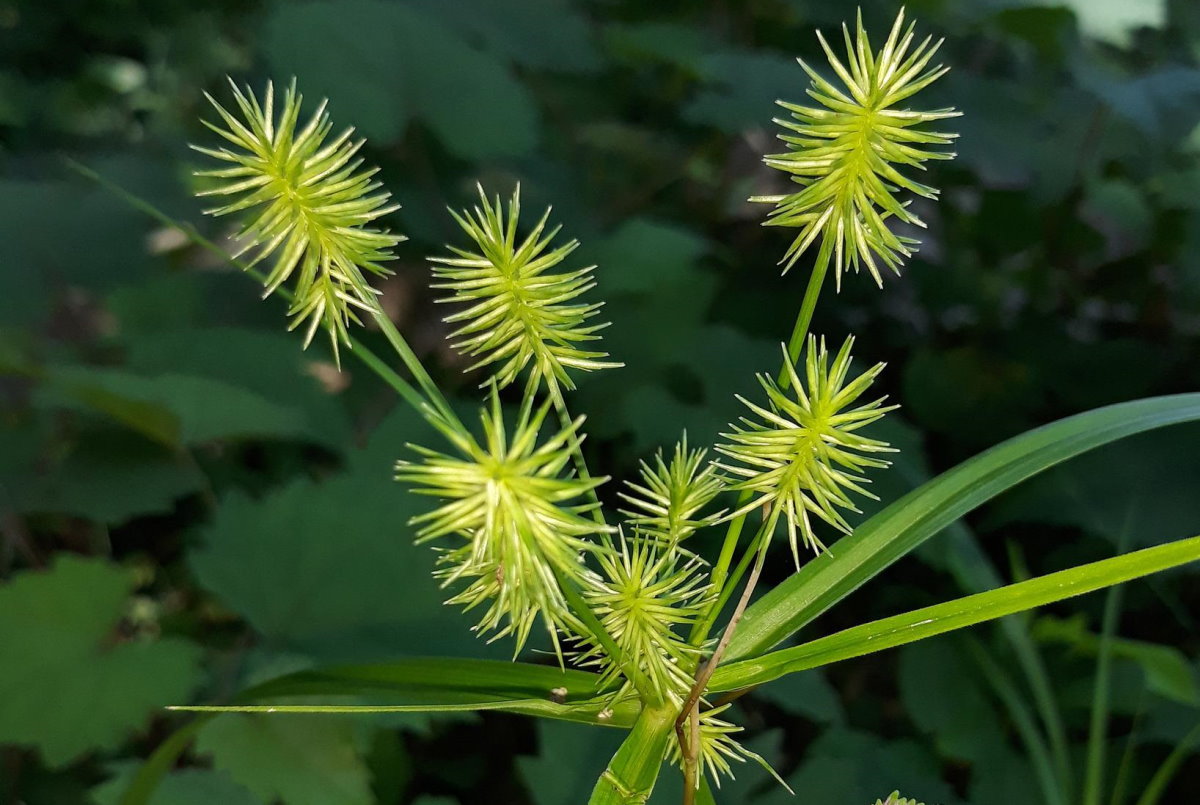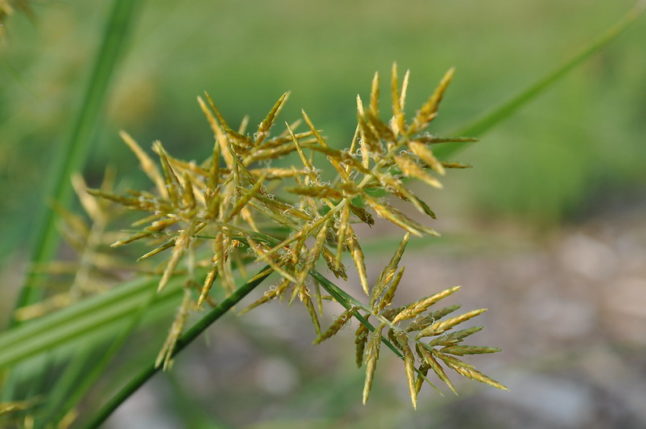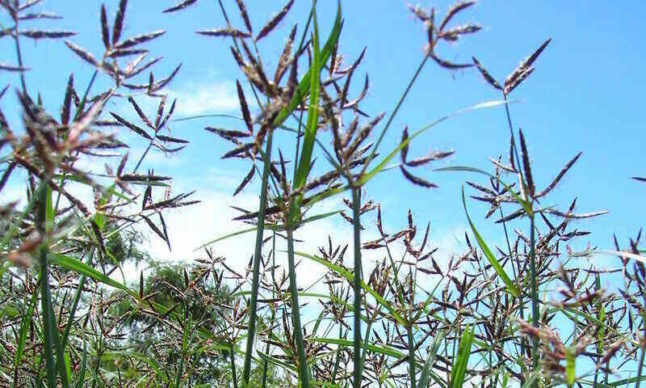
When you see clumps of grass-like weeds taking over your lawn, your first thought might be crabgrass. A closer look could reveal the distinctive spiky flowers and triangular stems of nutsedge.
This perennial weed can take over a yard quickly, so don’t delay on weed control. In this article you will learn more about what nutsedge is, and how to control nutsedge in your yard before it spreads.
What is Nutsedge?
Nutsedge, aka nutgrass, is an aggressive type of weed in the sedge family that is common in lawns, gardens, and agricultural zones. While often encouraged by excess moisture, it is drought-tolerant once established and can linger in your yard season after season.
Nutsedge is considered one of the most problematic weeds for agricultural crops, and it can have a major impact on turfgrass.
There are two major types of nutsedge plants that homeowners might encounter:
- Yellow nutsedge has a distinct yellow-green, glossy tint with pointed leaf tips and spiky yellow flowers.
- Purple nutsedge has dark green leaves with rounded tips, and reddish or purple-brown spiky flowers.
Both varieties of nutsedge are grass-like weeds with a distinctive triangular stem. Under the surface you’ll find underground roots called rhizomes and small bulbs called tubers, which grow at the end of the rhizome roots on yellow nutsedge and in chains along them in purple nutsedge.
These potato-like nutrient stores allow the plant to spread and go dormant over winter, which enables nutsedge to return season after season. In fact, similarly to potatoes, yellow nutsedge tubers are edible and have a sweet, nutty flavor. Just don’t try to eat the tubers if you’re treating the weeds with pesticides!
How to spot nutsedge in your yard? Keep an eye out for unusual patches of “grass” growing faster than the rest of your yard, as nutsedge grows much more quickly than turfgrass.

Photo credit: NY State IPM Program at Cornell University / Flickr / CC BY 2.0
How Does Nutsedge Spread?
Nutsedge typically enters a yard via bulk soil or nursery plants infested with nutsedge tubers. Once spread, tubers can remain dormant in soil over winter and result in new plants the next growing season.
If it’s able to sprout, nutsedge can form dense colonies of plants throughout a yard, crowding out existing lawn grass, vegetables, and flowers.
How to Control Nutsedge
Nutsedge is often difficult to eradicate due to its tubers, and handling an infestation is likely to be a lengthy process.
Note: Experts suggest a combination of lawn care, chemical, and mechanical methods is the best way to get rid of nutsedge. Unfortunately, if you avoid pesticide use on your lawn, the only effective options are lawn care and mechanical methods.
These methods of controlling nutsedge in your yard can help:
Lawn Care Methods
These healthy lawn care practices can help get a nutsedge infestation under control.
- Improve irrigation. Nutsedge thrives in moist soil. Water your grass deeply and infrequently.
- Repair broken sprinklers. Leaky sprinkler systems can cause water buildup and encourage nutsedge growth.
- Improve drainage and irrigation problems. Dethatch or aerate to prevent excess moisture accumulation, and consider adding a drain system.
- Clean tools and equipment that you’ve used in affected areas before using them elsewhere to prevent accidentally spreading tubers.
- Follow proper lawn care maintenance, including mowing, fertilizing, and maintaining soil pH.
- Monitor and manage insect infestations to avoid thin areas caused by hungry pests, where nutsedge could take over.
- Till areas of your lawn infested with purple nutsedge, then avoid watering to let the sun dry out the tubers. This method is only effective with purple nutsedge and requires repeated tilling and drying. It will not work in areas of your lawn where other plants need water.
Chemical Methods
To supplement good lawn care practices, post-emergent herbicides can help stop an existing nutsedge infestation. It’s best to apply these before tubers begin to mature in mid to late summer.
Water your lawn the day before you use herbicides, and avoid mowing before and shortly after application.
Note: Different herbicides are effective against different nutsedge varieties, so correctly identify what type you’re dealing with. Herbicides also vary in what grass and flower species they can be used around without hurting the rest of your yard.
These active ingredients in herbicide are commonly used to treat nutsedge:
- Bentazon (Southern Ag Basagran Sedge Control, Basagran T/O, Lesco LescoGran)
- Imazaquin (Image Nutsedge Killer)
- Halosulfuron (SedgeHammer Plus, Hi-Yield Nutsedge Control, Martin’s Nutgrass Eliminator, Monterey Nutgrass Killer II)
- Sulfentrazone (Gordon’s Trimec Nutsedge Plus Lawn Weed Killer, Ortho Nutsedge Killer for Lawns RTS, Blindside Herbicide)
Mechanical Methods
Nutsedge also can be removed by hand by digging or pulling out clumps. Dig at least 10 inches deep and 8-10 inches beyond the visible part of the plant to make sure all tubers are removed.
You should only try to pull out nutsedge with a small nutsedge infestation, as pulling it out can activate dormant tubers and make it worse. Be persistent to ensure all clumps are eradicated.

Forest and Kim Starr / Flickr / CC BY 2.0
How to Prevent Nutsedge
Once you have a nutsedge infestation under control, you’ll be searching for ways to make sure you never have to deal with it again. These methods of prevention can keep this stubborn weed away from your lawn:
- Inspect bulk soil to make sure it doesn’t contain nutsedge tubers.
- Check nursery plants for nutsedge infestation before purchasing.
- Maintain proper moisture levels to keep excess water from accumulating.
- Mulch your lawn with landscape fabrics, specifically those made with polypropylene polymers, or a thick, non-woven variety covered with bark or gravel mulch. These will suppress nutsedge growth, though you’ll still have to remove any plants that appear.
- Change landscape plantings in problem areas to increase shade – nutsedge prefers full sun.
FAQ about Nutsedge
Pulling out nutsedge can activate dormant tubers and make the infestation worse. Persistent pulling can help if the infestation is still young, or you can dig out clumps of the plant or apply herbicide.
Nutsedge tubers are often brought into a lawn by infested bulk soil or nursery plants. Nutsedge growth is encouraged by moist conditions and full sun.
Yes. Nutgrass is a common name for nutsedge.
Don’t Go Nuts Over Nutsedge
Nutsedge is an aggressive weed, and it can spread quickly, forming dense clumps and leaving behind tubers that keep it coming back. If you’re dealing with nutsedge, don’t spend your weekends digging and weeding. LawnStarter’s lawn care professionals can tackle this pesky plant for you.
Main photo credit: dB23 / Pixabay